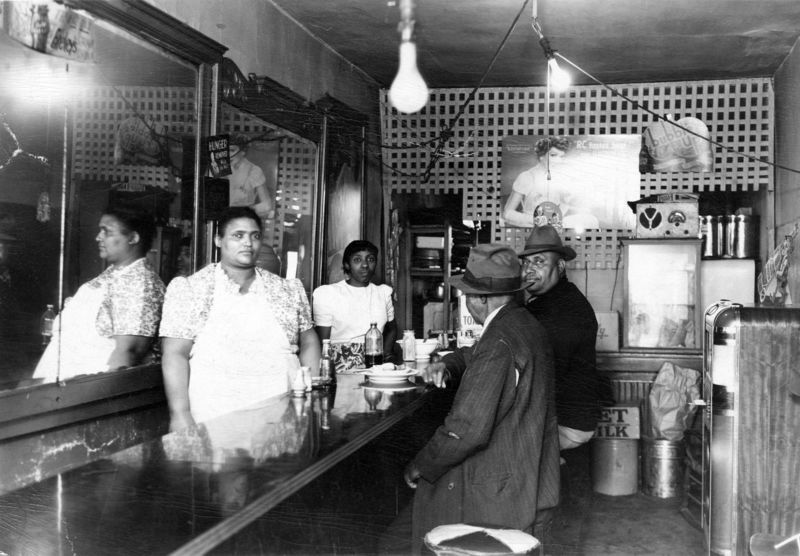Part 3 of a periodic series from "Our Black Children," an MU Thesis
by Jason Jindrich
Why Sharp End developed in the Flat Branch bottom is not known in detail.
John Kellogg’s assessment of historic Black space as “damp, poorly drained lowlands... of very steep slope” at the city margin (Kellogg 1977) may be an accurate assessment of why the former heart of Columbia became Negro occupied, but exactly why will have to be surmised. It is evident that the White community had generally abandoned the west end of the city by the 1865 freeman emigration and that region became the nucleus of Black Columbia.
Although rarely mentioned explicitly, flooding was probably a factor in the decision by the White community to leave the creek bottom, and why the land was available to Black investment.
Several authors refer to conditions that indicate water stood atop the soil for long periods in the bottomlands (Abram 1917; Brigham 1946; D. E. Hill 1910; Grant 1935; Kittel 1938; Knight 1915; Larson 1919; Martin 1934), and one author explicitly mentions that these areas flooded regularly (Goldstein 1944).
The association of low, wet lands with illness may also have influenced the decision of White landowners to abandon the bottomlands, but no mention of a fear of disease appears in any record.
Segregation by Soil
Soil type provides one indication that the White community was actively avoiding the Flat Branch bottom. Overlaying Elwang’s map of Negro residence (1904) on top of a standard soil survey map (Soil Conservation Service 1962) indicates that the majority of Columbia’s Negro population was confined to the region of Keswick soil near Flat Branch Creek (Map 4.1).
The most significant difference marking the boundary of Mexico and Keswick soil is the percent slope. Mexico is defined as a ridge top loess of 1 to 5% slope, while Keswick is a hillside loess of 5 to 25% slope.
Avoiding erosion and other problems associated with steep grade in the floodplain appear to be the reason behind the racial soil association.
From Slave to Businessman
For whatever reason the land was abandoned by the White community, the beginnings of Sharp End were in the newly emptied market square. In 1850 the freeman Black John Lang moved to Columbia from Kentucky, following his family who were the property of MU president James Shannon [an ardent defender of so-called "silent slavery" and anti-abolitionist buried in Columbia].
Lang was a remarkable businessman, and with the sponsorship of Shannon, he established the first butcher shop in Columbia on the site of the former market square and began the career that would make him the largest postbellum Black property holder in the city.
Although few records comment explicitly upon the progress of the Flat Branch area, it seems that Lang was the first Black investor into the bottomlands that would become the heart of the segregated community. Other investors followed, and by emancipation, entire blocks of the west end were Black-owned (Grenz 1979).
From Stream to Sewer
The low desirability of the area for White residents was compounded by the use of Flat Branch as a convenient alternative to sewers. In the course of an 1879 health crusade, it was noted that many residents and the slaughterhouse “…saved a long trip by depositing their cargoes in Flat Branch, just within the western limits of Columbia” when faced with the need to dispose of refuse (Crighton 1987).
Other initiatives in that year to rid the city of stagnant pools in natural depressions and restrictions on livestock were as unsuccessful as the drive for sewers. Late 19th century maps alternate between omitting the tributary stream that ran between Ash and Park Streets and labeling it as a sewer. In any event, by 1900 the axis of the main channel of the Flat Branch and tributary nearly defined the area of the town inhabited by the Black population (Map 4.2).
The only large colored population outside the bottomland area was northeast of the creek but in the equally poorly drained and undesirable location near the Wabash Railroad tracks.
Most of the houses in Railroad Row were tumbledown shacks that fronted the tracks instead of a road and noted for mud when wet and soot always (Martin 1934). In addition to the poor condition of their roads and residences, a stockyard, a coal yard, lumberyards, and several junkyards contributed to making it the least desirable area within the Black community.
Sidebar
Mobile Menu

 The Columbia Heart Beat
COLUMBIA, MISSOURI'S ALL-DIGITAL, ALTERNATIVE NEWS SOURCE
The Columbia Heart Beat
COLUMBIA, MISSOURI'S ALL-DIGITAL, ALTERNATIVE NEWS SOURCE

26
Fri, Dec
